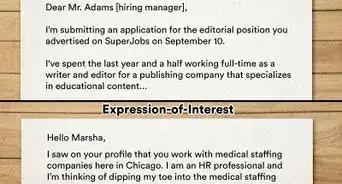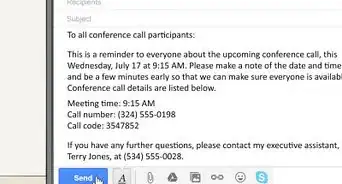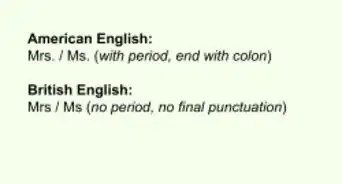This article was co-authored by Michael R. Lewis. Michael R. Lewis is a retired corporate executive, entrepreneur, and investment advisor in Texas. He has over 40 years of experience in business and finance, including as a Vice President for Blue Cross Blue Shield of Texas. He has a BBA in Industrial Management from the University of Texas at Austin.
wikiHow marks an article as reader-approved once it receives enough positive feedback. This article received 32 testimonials and 90% of readers who voted found it helpful, earning it our reader-approved status.
This article has been viewed 817,253 times.
A business profile is like a résumé for your company. It lists basic company details and gives you a chance to highlight your strengths. Just like a résumé, you should write each business profile with a purpose in mind. Use it as an opportunity to briefly state why potential clients should work with you, but give thorough and precise details.
Steps
Getting Down Company Information
-
1Put your basic information first. Readers need to know who they’re looking at before you get into the specifics. It will also demonstrate how organized and efficient you are. Make sure to give the company name, the year established, what your company does, who the principle is, all your contact info, and your website. If there are additional basic details relevant to your business, give them here.[1]
- For example, your header could be:
XYZ Semantics, LLC
Marketing Consultants | Est. 1975 in Las Vegas, NV
55 Corporation Drive, Las Vegas NV 56556 | ph. (555)555-5555, fax: (555)555-5556
Email: xyzsemantics@email.com | www.xyzsemanticsllc.com
- For example, your header could be:
-
2Talk about your company’s ideas. If you have a mission statement, put it here.[2] Otherwise, write out your company vision, guiding ethos, and a little about your history.[3] Telling who you are and what drives you gives your company a human element. It also gives you a chance to do some subtle advertising early on.
- This is a place you can afford to be a little vague. Mission statements are legally necessary for some businesses, and may need to be specific. For everyone else, try to state what you do without limiting yourself. You don’t want to scare away potential business that thinks you wouldn’t consider expanding into adjacent industries. But it is easy to overdo vague language.
- A bad example: "XYZ Semantics is a company driven by the pursuit of its dreams. We want to bring you with us on this journey. Our dedication to solutions and innovation make us the leading marketing consultants west of the Mississippi."
- A good example: "XYZ Semantics is seasoned and talented team of marketing consultants. Since 1975 we have helped our clients grow their business and profits. Though our methods are complex, our goal is simple: we want to help you sell your product to more customers."
Advertisement -
3Find out more specific details. Check with your secretarial or human resource staff to find out up-to-date details in several areas. You may not need to use all these, but having them on hand will make it easier when you sit down to craft the profile. Set up a way to streamline this process in the future, as you will want to update this information in your profile regularly.
- Number of employees
- Turnover. Low turnover can indicate stability, but either way it’s a good statistic to have on-hand.
- List of all business activities. What are all the areas you work in?
- Unique equipment or specialties. If you are the only company that produces, say, a rare machine part, you need to mention that.
- Certifications
- Imports/exports
- Your methodology and/or what software you use.
- Volume of output you can handle. Prospective clients need to know if you are prepared to meet their needs.
- Delivery stats. How many units do you ship in a given period?
- Major accounts or clients. This is a way to show prospective clients whether or not you are used to doing business with companies like theirs. It’s also another chance for subtle advertising.
-
4Sift through all this information. Since you want to keep the profile short, you can’t include every possible detail. Also, not all of them might be strengths. Pick out what might be relevant to include in your profile in various contexts. Keep the other information on hand for future reference, but put the important stuff in one place for easy access.
Dressing up a Business Profile
-
1Study other business profiles. Look first at competitors and other companies in the same type of business. Note the style and tone of the ones that stand out. If you have a business you really look up to, such as a leading national corporation, look at their profile. What do they do that stands out to you? Incorporate this style into your own.[4]
-
2Use accurate, up-to-date details. Before you sit down to write the profile, make sure you have the most recent numbers you can find. Prospective clients aren’t interested in your performance from five years ago. They want to know how you will deliver now. Get your staff to update you on these details regularly so you have to do less leg work when it comes time to write a new profile.
-
3Keep it short. Most times, you want people to read your profile as potential customers. Make sure they read all the way through by keeping it short and engaging. Show you respect their time and you don’t want to waste it. Short business profiles also indicate that you don’t need a lot of flowery language and decorations to show you are the best. Let the numbers speak for themselves.[5]
- For example, don't list every client you've had in the last 15 years. Keep the list short by including only the top 10 or so with high profiles. But make sure the language indicates they are not your only accounts!
-
4Avoid overly specific jargon as well as general statements.[6] You will inevitably use terms that people in your industry understand, but a fourth grader might not. However, don’t let the profile become an advertisement for your vocabulary. At the same time, avoid meaningless, vague statements. Experts in your industry will know fluff when they see it.
- Here are examples of poor wording:
- ”Simulated annealing and RPCs have the necessary infrastructure to interface with our overseas servers.”
- ”Our company optimizes synergy, productivity, and innovation while diminishing losses.”
- Here is an example of a targeted statement:
- ”We store data safely in our servers at home and in our international offices.”
- Here are examples of poor wording:
-
5Use clean formatting. Some companies and individuals let their creativity get away from them by going for excessively showy visual appeal. This doesn’t change the information presented, though. Pick a format that has lines and standard fonts to visually organize your profile. This is another way to ensure that the profile is easy to read.
-
6Mention why your company is best. This is a kind of advertisement for your business, so don’t be afraid to talk about your strengths. Although, they should never worry about the accuracy of your business profile. Mention specific numbers or awards to quantify your performance.
- Make it creative but don’t exaggerate. Find a nice middle ground between good writing that makes you stand out and showy prose. Write something that sounds nice in two paragraphs, and then edit it down to one.
- For example, don't write: "We are marketing consultants based in Las Vegas, NV. We help businesses in the region sell their products and services. If you sign with us, we will be contractually obligated to advise you ways to increase your business."
- But also don't write: "Semantics, LLC started in 1975, became the uncontested leader in marketing consultation in the United States by 1980. Our unrelenting and fervent attention to detail makes us the only good option for businesses hoping to increase sales. If you work with us, your profits will increase threefold in the first year."
- Opt instead for: "XYZ Semantics was named in Style & Marketing Magazine's 'Top 5 Marketing Consultants of the Southwest' list every year since 2005. Our team was selected from a variety of backgrounds to promote a creative environment. Choosing our services will not be the last good decision you make."
Expert Q&A
Did you know you can get expert answers for this article?
Unlock expert answers by supporting wikiHow
-
QuestionHow do I come up with a draft for a company profile?
 Michael R. LewisMichael R. Lewis is a retired corporate executive, entrepreneur, and investment advisor in Texas. He has over 40 years of experience in business and finance, including as a Vice President for Blue Cross Blue Shield of Texas. He has a BBA in Industrial Management from the University of Texas at Austin.
Michael R. LewisMichael R. Lewis is a retired corporate executive, entrepreneur, and investment advisor in Texas. He has over 40 years of experience in business and finance, including as a Vice President for Blue Cross Blue Shield of Texas. He has a BBA in Industrial Management from the University of Texas at Austin.
Business Advisor A good way to develop a business profile is to see what your competitors are doing. Visit their web and social media sites and review their content. Do you like the description of the business? How is your business different than the description of their business? What key information seems to be missing? The bottom line, an effective profile highlights the reason(s) that your business outshines the competition along with basic data about how to contact you physically, telephonically, and online.
A good way to develop a business profile is to see what your competitors are doing. Visit their web and social media sites and review their content. Do you like the description of the business? How is your business different than the description of their business? What key information seems to be missing? The bottom line, an effective profile highlights the reason(s) that your business outshines the competition along with basic data about how to contact you physically, telephonically, and online. -
QuestionHow should a business profile be written?
 Michael R. LewisMichael R. Lewis is a retired corporate executive, entrepreneur, and investment advisor in Texas. He has over 40 years of experience in business and finance, including as a Vice President for Blue Cross Blue Shield of Texas. He has a BBA in Industrial Management from the University of Texas at Austin.
Michael R. LewisMichael R. Lewis is a retired corporate executive, entrepreneur, and investment advisor in Texas. He has over 40 years of experience in business and finance, including as a Vice President for Blue Cross Blue Shield of Texas. He has a BBA in Industrial Management from the University of Texas at Austin.
Business Advisor The purpose of a profile is to let your potential customers know your location, the ways they can interact with you, the products or services you offer, and the key reason(s) they will want to do business with you (rather than your competitors). Put yourself in the mind of a potential customer and ask yourself, "What would I want to know about XYZ before doing business with them?"
The purpose of a profile is to let your potential customers know your location, the ways they can interact with you, the products or services you offer, and the key reason(s) they will want to do business with you (rather than your competitors). Put yourself in the mind of a potential customer and ask yourself, "What would I want to know about XYZ before doing business with them?"
References
- ↑ https://www.entrepreneur.com/business-news/10-things-every-small-business-website-needs/217499#!
- ↑ https://www.entrepreneur.com/encyclopedia/mission-statement
- ↑ https://www.businessnewsdaily.com/3882-vision-statement.html
- ↑ https://www.linkedin.com/pulse/how-make-your-business-stand-out-from-crowd-andrew-lehrfeld
- ↑ https://www.youtube.com/watch?v=TrBRfKvLQhY
- ↑ https://www.theguardian.com/small-business-network/2015/jun/26/business-jargon-words-avoid
About This Article
To write a business profile, use a standard font that's easy to read, and keep your profile short so potential customers aren't overwhelmed or bored by it. Also, avoid using a lot of technical jargon or flowery language so that people can easily understand your profile. You should start your profile with your basic information, like the name of your company, your address, and your contact information. Then, go over your company's mission statement and up-to-date details about your business. To learn how to include the best information in your business profile, keep reading!








































































